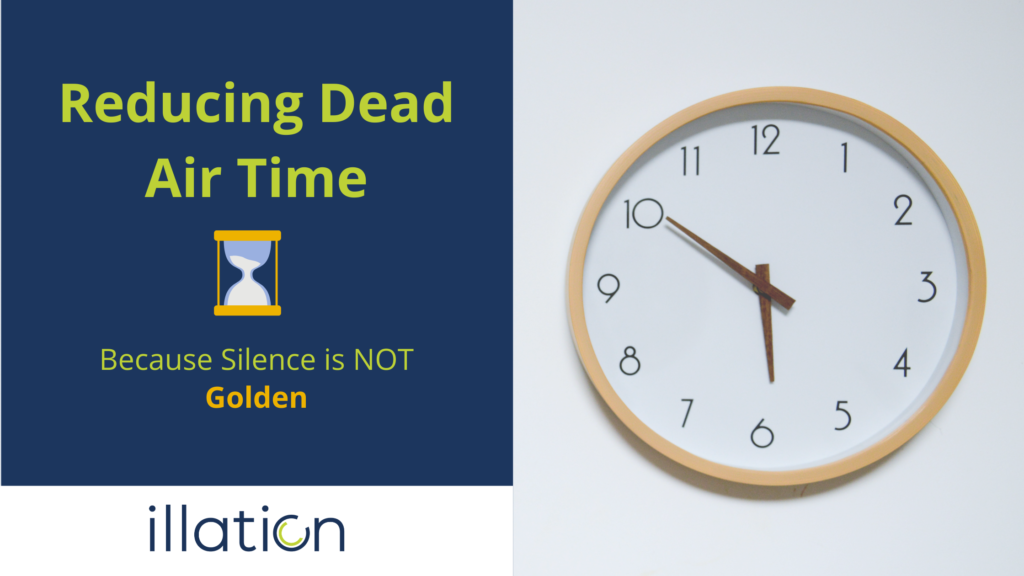When you’re dealing with a customer call centre, silence is everything but golden. On the contrary, your business pays for inefficiency as a result of long periods of silence. You want your team to be as efficient as possible.
Learn more about reducing dead air time in your customer support call centres so your team can operate at full capacity.
What Is Dead Air Time?
Dead air time (also called dead air space, occasionally) is a term used in call centre landscapes. As the name implies, dead air time refers to periods of silence during customer service calls, where neither the support agent or customer are taking part in conversation.

The term doesn’t apply to short gaps present in regular conversation. Instead, reducing dead air time is about getting rid of long periods of silence. Many contact centres refer to dead air time as silent periods lasting 30 seconds or longer.
A prime example of dead air time is when a customer is left on hold while the support agent is examining their query.
Why Is Dead Air Time Bad in Call Centres?
Silence during calls could indicate a variety of issues, but overall, it will hurt your bottom line and company reputation.
Some of the key issues that lead to dead air time include:
- Agents putting customers on hold for extended periods of time
- Problems with your contact centre system
- Connectivity problems (either from the contact centre or the customer’s side)
While callers are often willing to hold on for at least some amount of time during a service call, their patience will wear thin if they regularly experience long periods of waiting time.
Long periods of silence signal that your customer support centre is a headache to deal with. Bad customer support, in turn, could reduce the overall satisfaction of your customers and lower your Customer Satisfaction Index score.
“Callers that drop off as a result of long waiting times will often phone back later with the same query – meaning an increased workload on contact centre staff.”
Furthermore, too much dead air time is a clear sign that your contact centre operates inefficiently. Callers that drop off as a result of long waiting times will often phone back later with the same query – meaning an increased workload on contact centre staff.
How to Avoid Dead Air Time?
You can’t fix a problem if you aren’t even aware of its existence – this concept is applicable in every area of life, including your customer support calls.
The best way to deal with silence during your contact centre calls, is through incorporating an advanced speech analytics tool into your contact centre solution. Speech analytics allows you to monitor your customer support calls and pinpoint the cause of the issues.
“The best way to deal with silence during your contact centre calls, is through incorporating an advanced speech analytics tool into your contact centre solution.”
If you can establish how much dead air time you’re getting and why, you’ll be able to develop a strategy to solve your problem.
Support Agents and Dead Air Time
Unfortunately, dead air time is often caused by customer service agents putting callers on hold. To optimise your call centre and provide a better customer experience, it’s imperative that callers don’t spend too much time on hold when phoning in.
Phone calls are still one of the prime customer support channels for the South African CX landscape. Consumers (especially South African consumers) have high expectations when it comes to interacting with a real human for customer support.
Customers expect service reps to be adequately trained to assist with queries immediately. Long holding times encourage callers to disconnect prematurely – most probably leaving your customers frustrated.
Additionally, long holding times also indicate that service agents don’t know how to handle a query. Hence, callers are placed on hold while the support agents ask for managerial assistance, or search for information to assist in answering the customer’s query.
There are different ways you can assist your agents in avoiding dead air time from calls being placed on hold.
Train Agents to Provide Ongoing Updates
Proper agent training is one of the main ways you can improve your contact centre. A key way your agents can reduce long periods of silence is to keep interacting with customers throughout the call.
If an agent is occupied while investigating a consumer query, they should keep customers on the line whenever possible and provide updates on progress. This allows customers to feel included and shows active interest in resolving queries.
Ensure Agents Ask Enough Questions
Training agents to ask the customer questions during a call doesn’t only serve to reduce dead air time. Asking questions helps agents to better understand the nature of customer queries.
The agent should ideally ask questions while sourcing information regarding customer queries. For instance, agents can be trained to ask for feedback from customers regarding what they’ve done to try and resolve a problem themselves. This way the agent won’t be providing ineffective solutions that the customer has already explored.
Send Callers to the Right Agents
Not every support agent can be a specialist in all departments. Optimise your contact centre for more efficient resolution of queries by having relevant support departments readily available.
Customers typically phone in with queries related to specialised problems – such as billing and accounts, product feedback, technical support and so on.
Setting up a simple, user-friendly service menu (ex. allowing customers to press 1 for accounts, 2 for technical support etc.) at the beginning of phone calls, ensures customers are transferred to competent service agents from the start.
However, a service is only helpful if callers are able to choose the correct service options from the start. To avoid confusing customers, menu options must be as clear as possible. This way your callers won’t have to wait while being transferred to the correct departments after incorrect menu selections.
Speech Analytics for Contact Centres
As mentioned earlier, speech analytics can help you learn about the causes of dead air time in your contact centre. But there are many other benefits to implementing a speech analytics solution.
While customers are often frustrated with long periods of silence, there are times the customer will be happy to wait. Unfortunately, agents are often trained to keep the conversation going at any expense, even if some callers find this annoying.
Modern speech analytics tools transcribe all your contact centre phone calls, giving you written feedback on what customers are phoning in about and why.
“Modern speech analytics tools transcribe all your contact centre phone calls, giving you written feedback on what customers are phoning in about and why.”
An advanced speech analytics tool can help you optimise every area of your customer support. You can use the data you collect to decide what departments to include in your contact centre service menu options, as well as what common queries to answer on the FAQ section of your company website.
There are several possibilities as to how in-depth knowledge can change your approach to how you manage your contact centre.
Knowledge is power – and through collecting information regarding all your customer support interactions, you’ll have to knowledge to adapt your approach based on customer demands.




